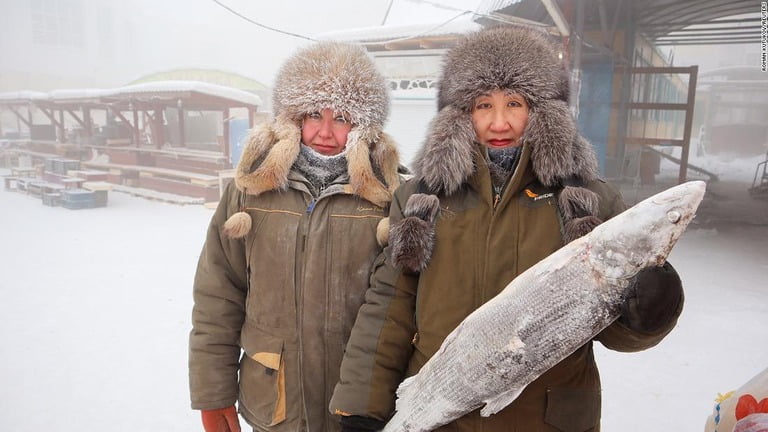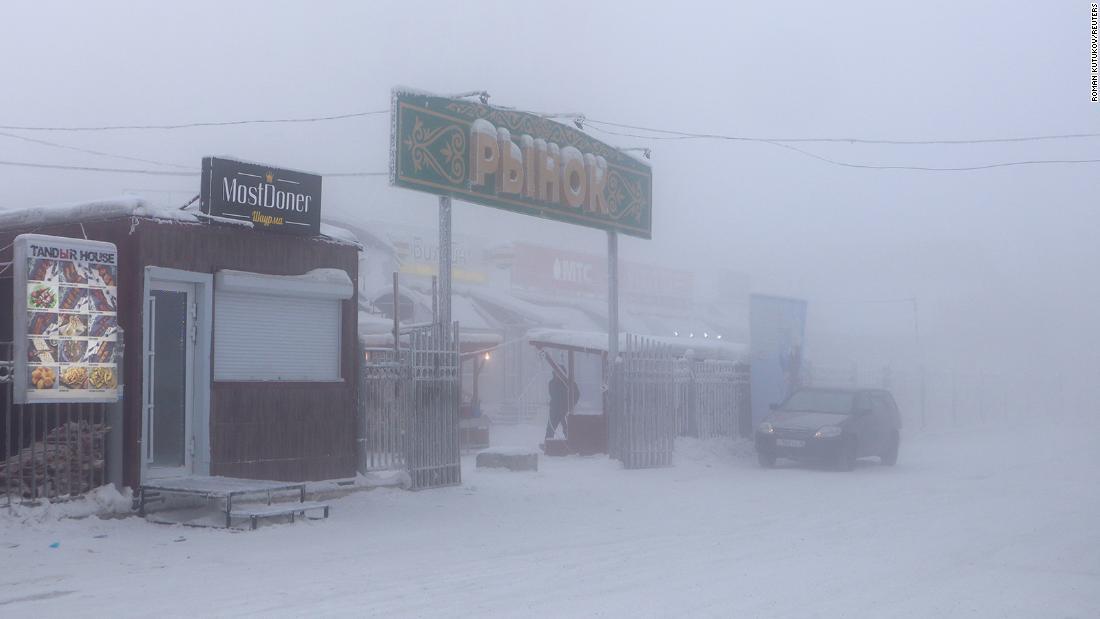最終更新日 2024年5月7日 01:06 The Unavailable Japan Weather Staff
世界で最も寒い都市、ヤクーツクで零下62.7度を記録
世界で最も寒い都市とされるロシア極東ヤクーツクの気温が零下62.7度を記録した。気象学者によると、この20年あまりで一番の冷え込みとなる。
ヤクーツクでは2日前、零下50度を記録していた。
シベリア東部に位置するヤクーツクはこのところ、異常に長い寒波に見舞われている。ロシアでは現在、広い範囲で記録的な低温を記録している。
1月はヤクーツクでも最も寒い月となる。大半の住民は凍(い)てつく気温に慣れているものの、暖かく過ごすために特に念入りな対策を講じている。寒すぎる空気は露出した皮膚に凍傷を引き起こすリスクが常にある。
2枚のマフラーに手袋や帽子、フードを何枚も着込んだ住民はロイター通信に「寒さとは戦えない」とコメント。「適応して状況に合った格好をするか、苦しむかのどちらか」と語った。
地元の市場で凍った魚を売っていた別の住民によると、鍵となるのは重ね着だ。「とにかく暖かい格好をするしかない。キャベツのように何枚も着込む」と語る。
2018年には、あまりの寒さにまつげが凍ったという住民も出た。
ヤクーツクは人口約35万5000人で、冬はロシアの基準から言っても極端なほど冷え込む。
CNN202201191
It’s now minus 80°F in the world’s coldest city
Thought your winter was cold? Temperatures in the world’s coldest city have plunged to minus 62.7°C (minus 80.9 degrees Fahrenheit) — the coldest in more than two decades, meteorologists say.
That comes just two days after the city’s previously set record of minus 50 degrees Celsius (minus 58 degrees Fahrenheit).
Yakutsk, the capital city of Russia’s Sakha Republic in eastern Siberia, is widely identified as being one of the coldest places in the world. Large parts of Russia are currently experiencing record low temperatures and Yakutsk is seeing an abnormally long cold snap.
January is the city’s coldest month and, although most are accustomed to freezing temperatures, residents in the remote region are taking extra precautions to keep warm.
Yakutsk winters can be extreme — even by Russian standards. And experts say that the extreme cold poses serious physical risks. The air is cold enough to numb exposed skin, making frostbite a constant hazard.
“You can’t fight (the cold),” one resident dressed in two scarves and multiple layers of gloves, hats and hoods told Reuters. “You either adjust and dress accordingly or you suffer.”
Layering, according to another resident selling frozen fish at a local market, was the key. “Just dress warmly. In layers, like a cabbage,” she said.
The city is shrouded in “ice fog” during winter. That occurs when “air is so cold that hot air from houses, people and cars cannot rise,” according to the North-Eastern Federal University in Yakutsk.
“It is not a good idea to walk out in the streets in winter when the temperature falls below -40C,” the university wrote in an advisory to new incoming students.
In 2018, it got so cold that some residents said their eyelashes froze.
With a population of roughly 355,500, Yakutsk has become one of Russia’s most rapidly growing regional cities.
The city sits on continuous permafrost, a layer of frozen ground consisting of soil, gravel and sand that is usually bound together by ice under Earth’s surface. Many houses are built on concrete piles.
It is known for its history of mining activities in the region. Major exports include diamonds and coal.
Because of its intensely subarctic climate, tourism plays a smaller role in contributing to the local economy. But the city still attracts adventurous travelers wanting to experience life in the coldest place on earth.
Like in other parts of the world, climate change has had a major impact on Yakutsk. The city drew international attention in July 2022 when haze from nearby wildfires tore through forests, blanketing the region in thick smoke.
Scientists expressed grave concerns about the increasing frequency of the fires brought about by climate change in the Siberian arctic.
世界の最低気温記録
直接地上で観測された世界の最低気温記録は−89.2 °C (−128.6 °F; 184.0 K)で、1983年7月21日に南極大陸にあるソビエト連邦のボストーク基地で記録された。
一方、1982年から2013年にかけて行われた南極大陸における地表面温度の人工衛星による観測では、2010年8月10日にドームA近傍の南緯81.8度 東経59.3度の地点で観測された−93.2 °C (−135.8 °F)が最低温度となった。この温度は気温と直接比較することはできないが、この地点における気温は公式な観測史上最低気温の−89.2 °C (−128.6 °F)よりも低かったであろうと信じられている。
そして、先に述べた2002年から2019年までの衛星観測データでは、詳しい場所は不明であるが、南極大陸内にて2016年に−110.9 °C (−167.6 °F)の地表面温度が観測されたと発表されている。
この他、2004年から2016年までの南極大陸における地表面温度のAquaとテラによる衛星観測について2018年に発表された論文によれば、東南極高原の到達不能極基地跡近くの南緯82.07度 東経60.72度の地点において2004年7月23日(協定世界時)に観測された−98.63 °C (−145.5 °F)の地表面温度が、この観測による地表面温度の最低記録であり、この他にも、12年間でドームAから到達不能極基地跡にかけての一帯を中心に100か所ほどで−98 °C (−144.4 °F)以下の地表面温度が観測されたという。
歴史的経過
1838年1月21日、ロシア帝国の商人ニベロフはヤクーツクで−60 °C (−76 °F; 213 K)を観測した。
1885年1月15日、H.ワイルドはベルホヤンスクで−68 °C (−90 °F; 205 K)が記録されたことを報告した。
その後、1892年2月には同じ場所で−69.8 °C (−93.6 °F; 203.3 K)の気温が観測されたことが報告された。
さらに、ソビエト連邦の研究者が1933年2月に、ベルホヤンスクの南東約650 km (400 mi)にあるオイミャコンで−67.7 °C (−89.9 °F; 205.5 K)が観測されたことを報告した。この記録は1940年代の間にソビエト連邦の文献で世界の最低気温記録として報告され、ベルホヤンスクの記録は遡及して−67.6 °C (−89.7 °F; 205.6 K)と訂正された。
次の信頼できる観測は1957年に南極大陸のアムンゼンスコット基地で行われ、5月11日に−73.6 °C (−100.5 °F; 199.6 K)、9月17日に−74.5 °C (−102.1 °F; 198.7 K)が観測された。
その後、1960年8月24日に南極高原にあるソビエト連邦のボストーク基地で−88.3 °C (−126.9 °F; 184.8 K)が記録された。この記録は、1983年7月21日にボストーク基地で−89.2 °C (−128.6 °F; 184.0 K)が記録されるまで、世界の最低気温記録であった。
1983年の記録は、直接観測の気温としては、現在でも世界の最低気温記録である。




